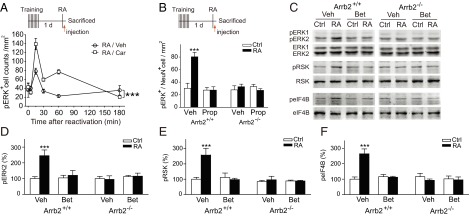Fig. 3.

Memory reactivation induces β-arrestin2–mediated β-AR-ERK translational signaling in the Enc. (A) Postreactivation immediate injection of Car (3.0 mg/kg, i.p.) enhanced reactivation-stimulated ERK activation in the Enc. n = 4–11. ***P < 0.001. (B–F) Arrb2+/+ and Arrb2−/− mice were treated with β-blocker or vehicle immediately after ORM reactivation, and brain samples were collected 15 min later for analysis of phosphorylation status. (B) Postreactivation injection of Prop (10 mg/kg, i.p.) and ablation of β-arrestin2 inhibited reactivation-induced increase in phosphorylated ERK (pERK)/NeuN double-positive cell counts in the Enc (n = 5–7 mice per group). ***P < 0.001 vs. no RA control (Ctrl). (C–F) Postreactivation injection of Bet (1.0 mg/kg, i.p) and ablation of β-arrestin2 inhibited reactivation-induced increase of phosphorylation of ERK (pERK, n = 5–6 per group), phosphorylation of ribosomal S6 kinase (pRSK, n = 5–6 per group), and phosphorylation of eukaryotic translation initiation factor 4B (peIF4B, n = 5–6 per group) in the Enc. ***P < 0.001 vs. Ctrl.
